NZ photos round 1: BIRDS
During my New Zealand adventure a few weeks ago, I took about 3,000 photos. Sorting and resizing them all is getting crazy, so I'm going to cut them into two batches: birds, and everything else.
Today I am posting BIRD PICTURES. Behind the cut are 85 pictures and 3 videos. It's at least 22mb, so please be patient as they load. If you are on a low-speed connection, I recommend clicking the link and then going to make a snack or something.
Many of these pictures are crappy, crappy photos, but all of the birds pictured are 100% wild. I have not included any pictures of any captive birds whatsoever.

Common mynah. One of the only three birds on the global 100 most invasive species list (the others being starlings and house sparrows.) I believe there is a small population of them in Florida, so I expect we'll see them here in Oregon within the next 50 years.

Austrailasian harrier. Everyone in NZ calls them "hawks" even though they really aren't. >:I
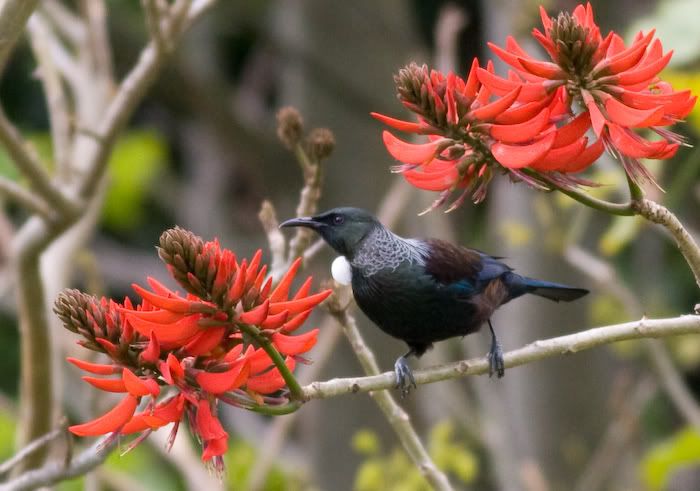
A tui, a highly-intelligent endemic nectar-eater. They are masters of song and amazing mimics, as can be seen in this great video.

A white-faced heron.



Pied shags.

Black-backed gull.

A female paradise shellduck with duckling.
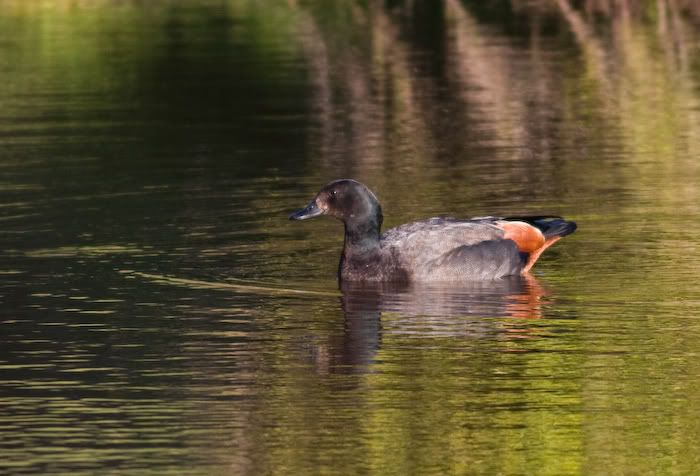
Here's the male shellduck.

Welcome swallow.

A nesting yellow-eyed penguin. Endemic, population: ~4,000. Considered one of the world's rarest penguins and possibly the most ancient of all living penguin species.

The worst picture ever of a shining cuckoo. This is the first cuckoo I have ever seen!

Redpoll. Introduced from Europe.

Brown creeper. Pretty darned different than America's brown creeper. This one is an endemic NZ species. It's maori name is "pipipi" and it makes me happy.

A California quail (introduced, obviously). The irony is that even though we have them where I live, I had to go to the complete other side of the globe before I managed to take a decent picture of one.

A brown quail (Australian introduction).

I know this is a horrible picture, but this is the best one I managed to get of this tiiiiny blue penguin just as it came tumbling out of the sea. The penguins feed all day and come back to their burrows at night. We sat for over an hour in the freezing cold waiting/hoping for a penguin to appear and this is the picture I have to show for it, so I'm posting it.

A pied oystercatcher.

A male chaffinch (European introduction.) I know they're not native but they are so amazingly cute and I love them.


OK so we were hiking and this guy was just hanging out on the trail. :O It is a brown kiwi, specifically a Stewart Island tokoeka. They are nocturnal and it is very unusual to find them at all, let alone during the daylight hours.
Please forgive the camera shakes... we were really trucking along and I was a bit winded when I shot this.

Dunnock (european introduction).

Banded dotterel (endemic).

Black-billed gulls (endemic).

Same as above.

New Zealand scaup (endemic).

Silvereye. These are like NZ's versions of chickadees.

A fiordland crested penguin. Endemic, population estimated around 2,500-3,000 breeding pairs and declining.

A NZ (wood)pigeon. These endemic birds are HUGE, bigger than a red-shouldered hawk (though they retain the tiny head of a normal city pigeon... hilariously). Right after I took this picture he devoured that whole sprig of leaves he's looking at. Just inhaled it.

A male stitchbird. Endemic, population: 500-1000. They are extinct on the mainland due to habitat loss and predation by introduced mammals and only exist on tiny, offshore islands where they are free from predators.

The white spots on their heads are actually tufts, which they can raise when they are agitated... which is virtually all the time.

This is the only shot I got of a saddleback, another endemic bird that is now extinct on the mainland (though it is doing well on offshore islands.)

Whitehead (endemic)

This is a takahe, a flightless member of the coot and rail family.
It was considered extinct in 1898. Fifty years later it was rediscovered eking out an existence in some of the most remote and inhospitable mountains in New Zealand. Breeding programs have helped boost its population to 224 birds.

These large birds are completely charming with floppy, soft-looking feathers and a disarming, squeaky call. I hope they do well in the future.

Here's a tui again. While they look all black at first, their plumage is a patchwork of colors and textures.

A male bellbird. The female looks about the same except for the purple face.

>:(

wtf, I don't even... I've never seen a bird do this. Yes, that's his tongue.
THEN
WE WENT
TO A
GANNET COLONY.

For years I've wanted to see gannets SO BAD. This was literally like a dream come true for me and I was full of squee for a week afterward. I took zillion pictures of them and I'm posting a lot of them and you're just going to have to live with it. (These are australasian gannets by the way.)





It is breeding season and they are all pairing up and building their nests.
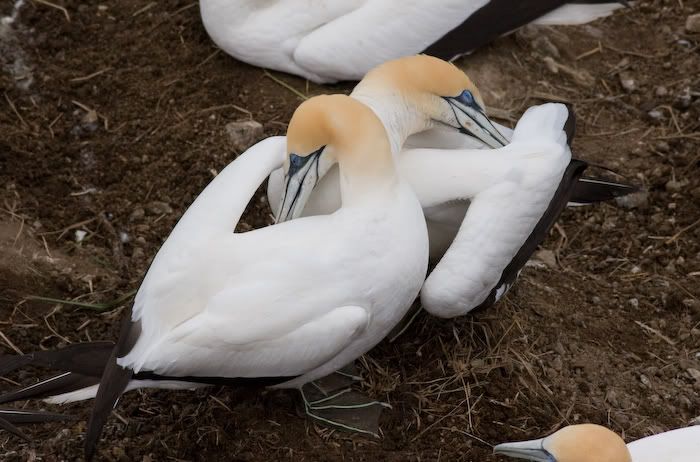
Preening.

Here is some somewhat crappy video I took in my excitement.
The rocky outcrops they breed on are subjected to a very stiff and constant wind. All they have to do to become airborne is spread their wings. Crowds of them dangle over the nesting area and search for parking spaces.

Once the gannet pair is reunited, they gently fence with their beaks...

...then rub necks. Then repeat ad nauseum.

There were also some white-fronted terns nesting nearby.

More white-fronted tern.

Pukekos! Pukekos are also in the coot family. They're about the size of a chicken but with much longer legs. In this picture, a tiny black pukeko chick has strayed far from its mother. Other pukekoes approach it and start pecking it viciously.

The mother notices its chick in peril and comes screaming in from the left, beak open and claws slashing.

Spectators gather and then are dragged into the fight, and it somehow turns into a six-pukeko brawl.


The enraged mother pukeko has another pukeko by the throat.


The chick is running for cover.

All the above pictures are in chronological order, but it's difficult to tell what happened except that some pukekos got their collective asses kicked. The moral of the story is not to mess with a pukeko's chicks.
Anyway, pukekos are in ever field in New Zealand (which is a lot of fields!) but I never get tired of seeing them. Also, I want to show you this picture to show you a comparison between a takahe and a pukeko. I was lucky enough to get a shot of them next to each other:

Moving on...
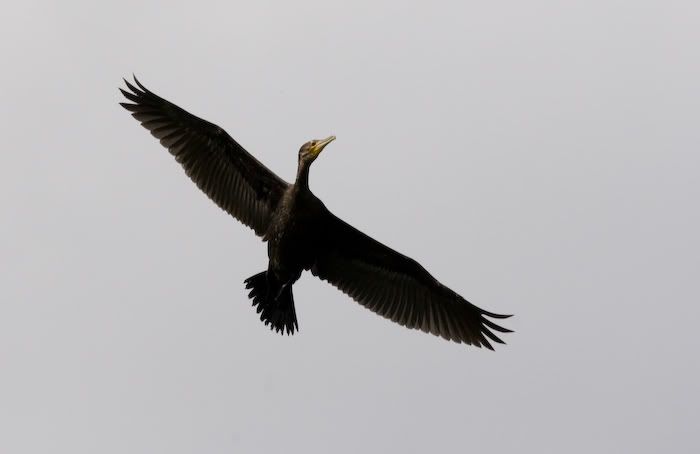
A black shag.

A grey duck. It looks like a mallard with Joker makeup.
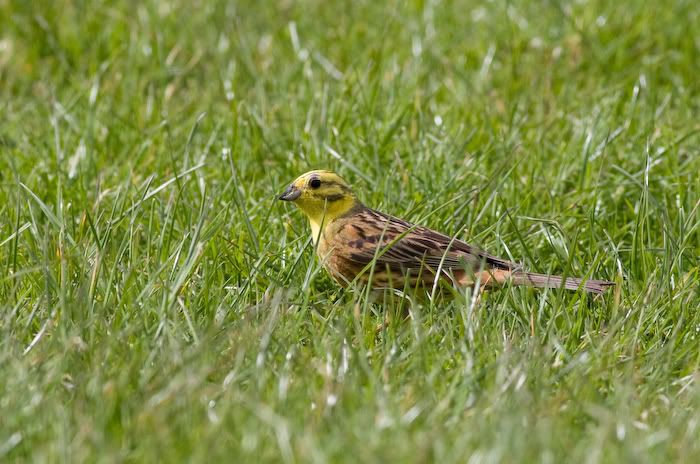
A yellowhammer, also introduced from Europe.

Yellowhammer again.

Grey warbler (endemic).

New Zealand dotterel. (Endemic, population: 1300) As he walked along the beach, he'd stick one foot inside a bit of seaweed and shake it about, then snap up all the fleeing insects.

This is the best picture I ever got of an eastern rosella. They're so crafty. They always saw me before I saw them and split. This was taken from inside a car, a million miles away, and then cropped excessively.

And this was the ONLY picture I got of a kaka, a large endemic parrot. D and I were hiking up some steep hills in the forest and we stopped to take a little break. We rested for a while, and just as we got up to leave, I saw an unusual leaf-wiggle out of the corner of my eye. I stared and stared and stared for the longest time before I realized that two kakas had been sitting right next to us the whole time. SO, SO CRAFTY.

A song thrush.

Varied oystercatcher.

Little shag.

Oh, a feral goose! What's up? Oh, you've got a nest back there? Is that--

8U!!

The coldest NZ pipit! It was snowing and he was eating a fried chicken wing.

A female blackbird. The males are jet black with bright orange features. Basically they're like American robins with different colors; their behaviors, appearance, and song are all about the same. They're even in the same genus (turdus...teehee).
This particular one hopped right up to us, looked us in the face, and pooped. Later she came back, looked us in the face, barfed, picked out all the bits that were still tasty, and went to look out over the water. So charming.

Speaking of robins, this is the New Zealand robin. It has absolutely no fear of humans at all, and when it sees you coming it drops whatever it's doing to come look at you from about two feet away. One picked at the mud stuck to my boots. If you do something interesting like dig a hole, flip over a bit of wood or stir up the leaf litter, they come right over to check out what you're doing in case something delicious has been exposed. We had one robin lead us for about a mile while hiking, flying up the path a little, then waiting for us to approach before flying along the path again. I WANTED TO TAKE THEM HOME WITH ME SO BAD.

It's a shy mollymawk. Isn't it amazing! This was the only time we saw any albatrosses in NZ, and the first time I'd ever seen them..

A red-billed gull.

This is a weka, another flightless rail. They are completely unafraid of humans. We found this one in a parking lot. As soon as we parked it came over to pick the bugs out of our grill. At one point I thought it might try to get in the car.

A weka chick.

They were wiggly and hard to take good photos of so I took a video.

Fantail (endemic). Like robins, they are thrilled to see humans and come get all up in your face. Their wings and tail are entirely too big for their bodies, and they are spastic beyond reason. They do crazy kung-fu flips and stunts as they snatch insects out of the air.

Doubtful eyebrows fantail.
Much to my excitement, I realized we've now seen most of the birds in the NZ segment in Sir. David Attenborough's The Life of Birds series. This segment here. We didn't see a kokako, despite our best attempts, and I'm pretty sure the only way to see a kakapo is in captivity.
Anyway, this was the total list of what we saw (I only counted the ones we saw in the wild):
Australian Magpies
Austrailasian harriers
starlings
house sparrows
eastern rosella
feral goose
Goldfinches
little shag
pigeons
blackbird
welcome swallow
tui
wild peacocks
pukeko
wild chicken
mynas
new zealand pigeon
kingfisher
pied stilt
white-faced heron
black-backed gull
caspian tern
mallard
California quail
sparkling cookoo
silvereye
Song Thrush
fantail
Paradise shellduck
New Zealand pipit
cape pigeon
austrailasian gannet
red-billed gull
variable oystercatcher
pied shag
chaffinch
blue penguins
yellow-eyed penguins
spur-winged plover
black swan
Redpoll
spotted shags
royal spoonbill
white-fronted tern
brown creeper
kaka
bellbird
tomtit
new zealand (stewart island) robin
brown kiwi
pied oystercatcher
banded dotterel
shy mollymawk
dunnock
Greenfinch
black-billed gull
yellowhammer
gray warbler
kea
fiordland crested penguin
NZ scaup
Weka
Whitehead
stitchbird
kakariki/red-crowned parakeet
takahe
saddleback
brown quail
ring-necked pheasant
NZ dotterel
black shag
grey ducks
Total: 72
Today I am posting BIRD PICTURES. Behind the cut are 85 pictures and 3 videos. It's at least 22mb, so please be patient as they load. If you are on a low-speed connection, I recommend clicking the link and then going to make a snack or something.
Many of these pictures are crappy, crappy photos, but all of the birds pictured are 100% wild. I have not included any pictures of any captive birds whatsoever.

Common mynah. One of the only three birds on the global 100 most invasive species list (the others being starlings and house sparrows.) I believe there is a small population of them in Florida, so I expect we'll see them here in Oregon within the next 50 years.

Austrailasian harrier. Everyone in NZ calls them "hawks" even though they really aren't. >:I

A tui, a highly-intelligent endemic nectar-eater. They are masters of song and amazing mimics, as can be seen in this great video.

A white-faced heron.



Pied shags.

Black-backed gull.

A female paradise shellduck with duckling.

Here's the male shellduck.

Welcome swallow.

A nesting yellow-eyed penguin. Endemic, population: ~4,000. Considered one of the world's rarest penguins and possibly the most ancient of all living penguin species.

The worst picture ever of a shining cuckoo. This is the first cuckoo I have ever seen!

Redpoll. Introduced from Europe.

Brown creeper. Pretty darned different than America's brown creeper. This one is an endemic NZ species. It's maori name is "pipipi" and it makes me happy.

A California quail (introduced, obviously). The irony is that even though we have them where I live, I had to go to the complete other side of the globe before I managed to take a decent picture of one.

A brown quail (Australian introduction).

I know this is a horrible picture, but this is the best one I managed to get of this tiiiiny blue penguin just as it came tumbling out of the sea. The penguins feed all day and come back to their burrows at night. We sat for over an hour in the freezing cold waiting/hoping for a penguin to appear and this is the picture I have to show for it, so I'm posting it.

A pied oystercatcher.

A male chaffinch (European introduction.) I know they're not native but they are so amazingly cute and I love them.


OK so we were hiking and this guy was just hanging out on the trail. :O It is a brown kiwi, specifically a Stewart Island tokoeka. They are nocturnal and it is very unusual to find them at all, let alone during the daylight hours.
Please forgive the camera shakes... we were really trucking along and I was a bit winded when I shot this.

Dunnock (european introduction).

Banded dotterel (endemic).

Black-billed gulls (endemic).

Same as above.

New Zealand scaup (endemic).

Silvereye. These are like NZ's versions of chickadees.

A fiordland crested penguin. Endemic, population estimated around 2,500-3,000 breeding pairs and declining.

A NZ (wood)pigeon. These endemic birds are HUGE, bigger than a red-shouldered hawk (though they retain the tiny head of a normal city pigeon... hilariously). Right after I took this picture he devoured that whole sprig of leaves he's looking at. Just inhaled it.

A male stitchbird. Endemic, population: 500-1000. They are extinct on the mainland due to habitat loss and predation by introduced mammals and only exist on tiny, offshore islands where they are free from predators.

The white spots on their heads are actually tufts, which they can raise when they are agitated... which is virtually all the time.

This is the only shot I got of a saddleback, another endemic bird that is now extinct on the mainland (though it is doing well on offshore islands.)

Whitehead (endemic)

This is a takahe, a flightless member of the coot and rail family.
It was considered extinct in 1898. Fifty years later it was rediscovered eking out an existence in some of the most remote and inhospitable mountains in New Zealand. Breeding programs have helped boost its population to 224 birds.

These large birds are completely charming with floppy, soft-looking feathers and a disarming, squeaky call. I hope they do well in the future.

Here's a tui again. While they look all black at first, their plumage is a patchwork of colors and textures.

A male bellbird. The female looks about the same except for the purple face.

>:(

wtf, I don't even... I've never seen a bird do this. Yes, that's his tongue.
THEN
WE WENT
TO A
GANNET COLONY.

For years I've wanted to see gannets SO BAD. This was literally like a dream come true for me and I was full of squee for a week afterward. I took zillion pictures of them and I'm posting a lot of them and you're just going to have to live with it. (These are australasian gannets by the way.)





It is breeding season and they are all pairing up and building their nests.

Preening.

Here is some somewhat crappy video I took in my excitement.
The rocky outcrops they breed on are subjected to a very stiff and constant wind. All they have to do to become airborne is spread their wings. Crowds of them dangle over the nesting area and search for parking spaces.

Once the gannet pair is reunited, they gently fence with their beaks...

...then rub necks. Then repeat ad nauseum.

There were also some white-fronted terns nesting nearby.

More white-fronted tern.

Pukekos! Pukekos are also in the coot family. They're about the size of a chicken but with much longer legs. In this picture, a tiny black pukeko chick has strayed far from its mother. Other pukekoes approach it and start pecking it viciously.

The mother notices its chick in peril and comes screaming in from the left, beak open and claws slashing.

Spectators gather and then are dragged into the fight, and it somehow turns into a six-pukeko brawl.


The enraged mother pukeko has another pukeko by the throat.


The chick is running for cover.

All the above pictures are in chronological order, but it's difficult to tell what happened except that some pukekos got their collective asses kicked. The moral of the story is not to mess with a pukeko's chicks.
Anyway, pukekos are in ever field in New Zealand (which is a lot of fields!) but I never get tired of seeing them. Also, I want to show you this picture to show you a comparison between a takahe and a pukeko. I was lucky enough to get a shot of them next to each other:

Moving on...

A black shag.

A grey duck. It looks like a mallard with Joker makeup.

A yellowhammer, also introduced from Europe.

Yellowhammer again.

Grey warbler (endemic).

New Zealand dotterel. (Endemic, population: 1300) As he walked along the beach, he'd stick one foot inside a bit of seaweed and shake it about, then snap up all the fleeing insects.

This is the best picture I ever got of an eastern rosella. They're so crafty. They always saw me before I saw them and split. This was taken from inside a car, a million miles away, and then cropped excessively.

And this was the ONLY picture I got of a kaka, a large endemic parrot. D and I were hiking up some steep hills in the forest and we stopped to take a little break. We rested for a while, and just as we got up to leave, I saw an unusual leaf-wiggle out of the corner of my eye. I stared and stared and stared for the longest time before I realized that two kakas had been sitting right next to us the whole time. SO, SO CRAFTY.

A song thrush.

Varied oystercatcher.

Little shag.

Oh, a feral goose! What's up? Oh, you've got a nest back there? Is that--

8U!!

The coldest NZ pipit! It was snowing and he was eating a fried chicken wing.

A female blackbird. The males are jet black with bright orange features. Basically they're like American robins with different colors; their behaviors, appearance, and song are all about the same. They're even in the same genus (turdus...teehee).
This particular one hopped right up to us, looked us in the face, and pooped. Later she came back, looked us in the face, barfed, picked out all the bits that were still tasty, and went to look out over the water. So charming.

Speaking of robins, this is the New Zealand robin. It has absolutely no fear of humans at all, and when it sees you coming it drops whatever it's doing to come look at you from about two feet away. One picked at the mud stuck to my boots. If you do something interesting like dig a hole, flip over a bit of wood or stir up the leaf litter, they come right over to check out what you're doing in case something delicious has been exposed. We had one robin lead us for about a mile while hiking, flying up the path a little, then waiting for us to approach before flying along the path again. I WANTED TO TAKE THEM HOME WITH ME SO BAD.

It's a shy mollymawk. Isn't it amazing! This was the only time we saw any albatrosses in NZ, and the first time I'd ever seen them..

A red-billed gull.

This is a weka, another flightless rail. They are completely unafraid of humans. We found this one in a parking lot. As soon as we parked it came over to pick the bugs out of our grill. At one point I thought it might try to get in the car.

A weka chick.

They were wiggly and hard to take good photos of so I took a video.

Fantail (endemic). Like robins, they are thrilled to see humans and come get all up in your face. Their wings and tail are entirely too big for their bodies, and they are spastic beyond reason. They do crazy kung-fu flips and stunts as they snatch insects out of the air.

Doubtful eyebrows fantail.
Much to my excitement, I realized we've now seen most of the birds in the NZ segment in Sir. David Attenborough's The Life of Birds series. This segment here. We didn't see a kokako, despite our best attempts, and I'm pretty sure the only way to see a kakapo is in captivity.
Anyway, this was the total list of what we saw (I only counted the ones we saw in the wild):
Australian Magpies
Austrailasian harriers
starlings
house sparrows
eastern rosella
feral goose
Goldfinches
little shag
pigeons
blackbird
welcome swallow
tui
wild peacocks
pukeko
wild chicken
mynas
new zealand pigeon
kingfisher
pied stilt
white-faced heron
black-backed gull
caspian tern
mallard
California quail
sparkling cookoo
silvereye
Song Thrush
fantail
Paradise shellduck
New Zealand pipit
cape pigeon
austrailasian gannet
red-billed gull
variable oystercatcher
pied shag
chaffinch
blue penguins
yellow-eyed penguins
spur-winged plover
black swan
Redpoll
spotted shags
royal spoonbill
white-fronted tern
brown creeper
kaka
bellbird
tomtit
new zealand (stewart island) robin
brown kiwi
pied oystercatcher
banded dotterel
shy mollymawk
dunnock
Greenfinch
black-billed gull
yellowhammer
gray warbler
kea
fiordland crested penguin
NZ scaup
Weka
Whitehead
stitchbird
kakariki/red-crowned parakeet
takahe
saddleback
brown quail
ring-necked pheasant
NZ dotterel
black shag
grey ducks
Total: 72